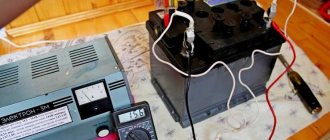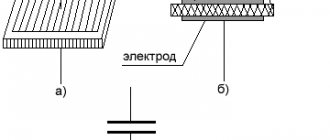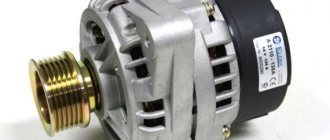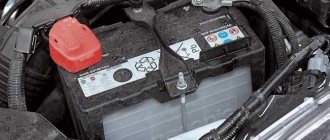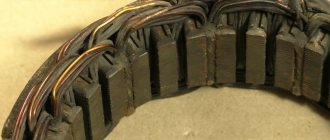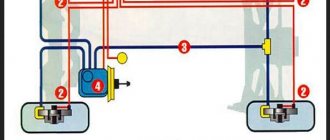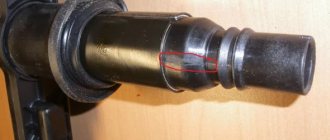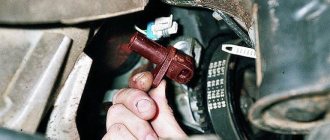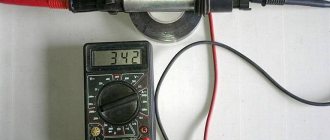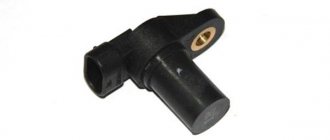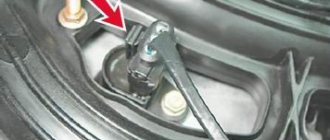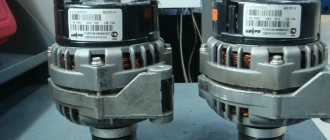The battery is an important component, without which the car simply will not run. Many drivers treat the battery as a consumable item - they replace it with a new one when it starts to act up. Power supplies “age”, but this can be slowed down if they are serviced on time and operating rules are followed. Testing the battery with a multimeter will allow you to evaluate its performance.
Checking the battery with a multimeter is necessary in order to notice possible malfunctions in time.
How to check the battery
When learning how to measure battery capacity with a multimeter, you need to consider the procedure for a vehicle battery.
A full check of the autonomous power source will allow you to avoid problems in the vehicle’s electrical network and extend the life of the battery. First, the battery must be disconnected from the machine system. It is allowed to disconnect only the “minus” contact. Next you need to turn on the multimeter. The test mode is set to the range from 0 to 20 V.
The multimeter probes are connected to the battery contacts. A red wire is connected to the positive terminal, and a black wire is connected to the negative terminal. If this procedure is performed correctly, the measurement result will appear on the device screen.
Measurements while the engine is running
Place the car on a level surface, open the hood, put the handbrake on and start it. When the engine is running, the generator and voltage regulator operate, which charge the battery. Therefore, the voltage at the terminals should be within 13.5-14 volts. In some cars, when the battery is discharged and the air temperature is low, the electronics automatically increases the voltage to speed up charging. In this case, it should fall smoothly as it charges. If this does not happen, the electrolysis process is activated in the banks. The electrolyte will begin to boil away rapidly. Overcharging is especially dangerous for modern gel batteries with limited gas emissions.
A voltage of less than 13.4 volts is a sign of undercharging. Operating in such conditions promotes sulfation of the plates and shortens battery life.
When measuring voltage, you need to turn off all powerful consumers: headlights, heater, audio system. Otherwise, the power of the generator when idling will not be enough to maintain the optimal voltage level.
There are several possible reasons for low voltage at the terminals:
- Poor contact.
- Generator failure.
- Voltage regulator malfunction.
You cannot operate a machine whose battery is in undercharge mode. The cause of the failure must be immediately localized and eliminated. If the voltage at the terminals and the output of the generator is very different, you need to clean the contacts on the battery with sandpaper or a file.
After checking without load, you need to turn on the headlights and other powerful energy consumers, add engine speed and repeat the measurements. If at high speeds under load the voltage drops to 13.4 volts or lower, diagnostics of the generator system and control unit is required.
How to test a battery with a multimeter with the engine turned off?
The average indicator, when checking the battery with a multimeter, with the engine not running, should be in the range of 12.5–13 V, with the upper value indicating 100% charge, and the lower value indicating 50%. The numbers are approximate, but the general picture is easy to understand. Also, do not forget that you should take readings immediately before the trip, and not after it, as soon as you have turned off the engine. It is especially good to carry it out when the car has not been used for some time, for example, in the morning after a night in the garage. This shows how well the battery can hold a charge.
Now you understand how to check the charge of a car battery with a multimeter. This device is worth purchasing for every motorist. Some rely on the on-board computer, but it does not provide sufficient accuracy. The built-in voltmeter is connected to the circuit of devices that consume energy, and not directly to the battery, therefore, part of the electricity is consumed “on the road”.
Useful tips and general recommendations
Do not check or use leaking batteries. If liquid oozes from them, they can no longer be used anyway.
You cannot store discharged batteries at home, because... they can begin to leak electrolyte and damage nearby things. In addition, their contents are toxic.
Batteries discharge unevenly. If the equipment does not work well, do not throw away all the batteries at once. They need to be checked with a multimeter. Working batteries can be used.
Do not test batteries in a damp room. The surface on which the multimeter is placed must be level and stable.
To extend the service life of elements, follow the rules:
- do not overheat or overcool the batteries;
- use the same power sources in the same device.
The tester will only provide a rough estimate of the condition of the battery. Accurate measurements are made on factory equipment using other methods.
How to Visually Check a Car Battery Case and Cables
Now it's time to check the physical condition of your battery. A damaged battery case can not only prevent the battery from working properly, but can ultimately kill it. To check it, you need to remove it from your car.
Disconnect the cables first, starting with the ground terminal and then the positive terminal. Now unscrew the clamping mechanism to remove the battery from the tray. Make sure the holding mechanism works. If it doesn't exist, install it. This equipment prevents the battery from rebounding and becoming damaged while the vehicle is in motion.
Place it on a work surface or similar surface. Carefully inspect the battery case for possible damage. Check for a bulging side or cover, cracks around the housing, or damaged terminals. If your battery is damaged, replace it. Overcharging and internal short circuit will cause the battery to swell as the acid turns to gas. So if you notice signs of a bulge, check the charging system as well.
Now check the cables. Check the insulation around the cables and the condition of the cable threads for wear, cracks or fraying. Replace them if necessary. Make sure the clamp mechanism on your battery is working.
Starting current strength
We switch the multimeter to pointer A. In this position, we have the opportunity to check the current strength. This value is measured in mAm. To carry out such a measurement, you need to connect the tester probes to the battery terminals.
In order to check batteries with high power and voltage, you need to change the position on the switch, namely: select the “10A” mark.
To check the current strength of the battery from a car, only a professional device (for example, Bosch BAT-131) is suitable. The above methods will be unproductive, because the starting current of the car battery can be more than a hundred amperes.
What parameters can be checked?
Using a multimeter, you can measure voltage with high accuracy. By the magnitude of the electrical voltage, you can determine whether the battery is charged or the element needs to be charged with direct current.
Using a multimeter, you can check the voltage not only of acid batteries, but also of cell phone batteries. To check the mobile phone's battery charge level, the device is switched to the mode for measuring direct current up to 20 V. In this mode, the digital device allows you to measure voltage with an accuracy of hundredths of a volt.
The screwdriver battery can also be easily checked with a multimeter. The rated voltage of the device, in this case, can be found out from the documentation of the power tool, and if the voltage is less than this value, then the battery must be charged.
The battery capacity can also be checked with a multimeter. For this purpose, you can use several methods.
You can check current leakage using a multimeter. If it is necessary to measure this parameter on a car, then in addition to the current leakage on the body, the leakage in the vehicle’s on-board network is also checked.
In this way, you can prevent rapid discharge of the battery and increase its service life.
How to check battery charge with a multimeter?
Determining the condition of a lithium-ion (the most common type of modern battery) battery is quite simple if you follow these instructions:
- Disconnect the energy storage device from the car and wait 5-6 hours.
- The multimeter should operate in the “voltage” mode (voltage test).
- A standard lithium battery produces current in the range of 12.7–13.2 volts. The switch is set to 20 or closest to it. This is how the voltage is measured from this value and below.
- The wires coming from the device are connected to the battery: red to the positive terminal, black to the negative terminal. If the wires are the same color, then you should focus on their markings and connect them to opposite charges, minus to plus and vice versa.
General information
A multimeter allows you to find out the real voltage of the battery, and the readings will be as accurate as possible. In turn, by the voltage you will understand whether the car battery is charged or needs power.
By the way, you can use a multimeter to find out the voltage of phone chargers. Video on how to check 12V with a multimeter using the example of such a power supply:
This meter also allows you to detect current leakage. At the same time, it is important to check for leaks not only on the body, but also in the on-board vehicle network.
In general, checking the battery with a multimeter is possible by:
- capacity;
- resistance;
- current or amperage;
- charge (voltage).
Thanks to this range of measurements, you can minimize the likelihood of rapid battery discharge and increase its service life. And if, for example, you know how to check the starting current of a battery with a multimeter, then you will understand why the engine does not start.
In this useful article we will tell you about the most important things. Let's start with how to measure a battery's charge with a multimeter.
Using a hydrometer to check battery fluid
- Remove the caps from the top of the battery.
- Immerse the tip of the hydrometer into the first cell of the battery and squeeze out the hydrometer bulb.
- Release the bulb so that the electrolyte enters the hydrometer needle.
- Read the specific gravity of the electrolyte as indicated in the instructions on the tool packaging.
- Record your values and perform the same test on the remaining cells.
- Compare your results with the results of the tool manufacturer's instructions.
Basically, if your readings fall between 1.265 and 1.299, your battery is charged. When your readings drop below 1.265, your battery will not be sufficiently charged. In most cases, a slow or fast charge will help restore charge and improve the chemistry in the battery. However, a difference between 25 and 50 points or more (the point is 0.001) between any of your readings indicates that the battery is sulfated and you need to replace it.
Battery voltage
The voltage is tested at the battery terminals without load.
To carry out such diagnostics, just disconnect the minus terminal from the battery and take measurements with a measuring device. A battery that has a one hundred percent charge, has no defects and is in good working order, will show a voltage value of twelve V.
If the indicator is at eleven V, the battery has a charge of fifty percent. And if the value is below eleven, it means the battery has problems and malfunctions or is discharged.
Attention! You can also check high voltage (current in the outlet or technical batteries) with a multimeter. To do this, select 200 V on the switch.
If you see a number with a “-” sign on the display, this means that the cables are not connected correctly. Before checking the battery, be sure to carefully connect the red cable to the “plus” terminal, and the black cable to the “minus” terminal.
How to check the battery charge using the indicator
Many maintenance-free batteries have charge indicators that allow you to visually determine the condition of the battery. This option first appeared on Japanese products and quickly gained popularity due to its convenience and accessibility.
The hydrometer, as the indicator is called, is a transparent window on the battery cover. The color of the window changes depending on the condition of the battery:
- Green —full charge.
- Gray or white - need to be charged.
For some indicators, the window turns red when capacity is lost.
The principle of operation of the device is based on changes in the density of the electrolyte at different charge levels. It works like this:
A tube with a green float is attached to the window.
- When charging the battery, the density of the electrolyte increases and the float rises, approaching the window.
- If the battery is discharged, the density drops and the ball sinks in the electrolyte. As a result, the indicator window changes color to gray or black.
Some indicator models have a red ball that floats up when the density of the electrolyte decreases. This provides a red indication of the discharge.
When the electrolyte level drops, not the ball, but the electrolyte itself will be visible through the window. To prevent the destruction of the plates, you need to add distilled water to the jars and charge the battery.
The advantage of the indicator is that the device allows you to determine the condition of the battery without the use of special instruments. This is convenient when purchasing a battery or in road conditions when you need to quickly check the condition of the battery. However, indication using a float does not always allow one to draw accurate conclusions about the performance of the battery. Therefore, when in doubt, you should use a multimeter or a load fork. They are also useful when you need to check a battery that is not equipped with an indicator.
Overcharge
Overcharge can be checked in voltage mode.
To begin with, determine the voltage, and only after that compare the nominal numbers with the received one. If the indicator obtained as a result of the test is more than twenty percent greater than the nominal value, then the conclusion is obvious - the battery is overcharged.
Overcharging a battery is a dangerous negative phenomenon. The result is boiling of the batteries with the release of life-threatening gases, explosion or ignition of the battery.
How to Test Battery Terminals Using a Multimeter
Dirty, corroded or loose terminals will lead to starting or no-starting problems and are one of the main reasons people think they have a "dead battery". Sometimes such problems are difficult to detect with a simple visual inspection.
Here you will use a voltmeter (or multimeter set to voltage) to check the battery terminals for voltage drop so you can understand the status of your battery connections.
First turn off the ignition system. Do this by temporarily disconnecting the ignition coil or removing the fuse, or the fuel pump relay (if necessary, find your vehicle's owner's manual or your vehicle's repair manual to locate the coil or fuse). This will prevent your engine from starting.
Use the red positive wire to touch the positive terminal of the battery and hold. Touch the black wire (negative) of your meter to the terminal of the negative wire that goes onto the battery. Have a helper crank the engine. If your meter registers more than 0.5 volts, you will need to clean or check the physical condition of the terminal and terminals.
Now check the other battery terminal. This time, however, use the black probe of your meter to touch the negative terminal of the battery. Now touch the red probe of your meter to the cable terminal connecting to the same battery terminal. Have your helper start the engine and check the voltage reading on your meter. If it exceeds 0.5 volts, you need to check the battery terminal for damage or clean it.
Checking current for leakage
In exactly the same way, you can measure current leakage in a car - with a current clamp or a multimeter. The measurement scheme will be the same as the previous one. Before starting the measurement, you must turn off the engine and disconnect obvious consumers:
- lighting equipment;
- car radio;
- other loads.
If the measured leakage current exceeds a reasonable value (the approximate sum of the remaining loads - car alarms, other car electronics that cannot or are difficult to turn off), you need to look for a problem - short circuit, insulation or contamination overlap, etc. You must understand that if a leak occurs through a contaminated battery case (oil stains, electrolyte, adhering conductive dust), then it will not be detected in this way - the current path will be directed past the circuit being measured. Therefore, at the first suspicion of abnormal consumption, you need to clean the battery case from dirt (for example, wash it with detergents).
Leakage current paths along a contaminated housing.
For more details, read the article: How to find current leakage in a car with a multimeter
How to check the “amperage” of a battery with a multimeter?
To determine the current that your battery produces, you will need to create a circuit with a load. Its role is played by any device or equipment that consumes electricity. To take measurements you will need to take the following steps:
- The device is set to ampere measurement mode, and the switch on it is set to alternating current, which is designated by the English letters AC.
- Disconnect the positive terminal of the battery and replace it with the negative wire of the measuring device.
- To the equipment that acts as a load, connect the negative terminal of the battery and the meter probe with a positive charge.
- Depending on the design, look at the displayed number or count it on the instrument scale.
A serviceable and fully charged battery exhibits readings in the range of 12.6–13 V.
Functions of universal measuring devices
It is impossible to measure the inrush current with a multimeter directly, without additional devices. This is due to the fact that the characteristics of household appliances do not allow high currents to be controlled. The maximum limit is 30 amps, but this will be quite an expensive device. How to measure the battery current if it reaches several hundred amperes? You can use a shunt and measure the voltage drop across it, but more on that later. Now we list all the procedures that can be performed with a multimeter:
- It can be used to measure the amount of charge expressed as voltage. To do this, the device must be switched to the appropriate mode.
- A universal measuring device allows you to determine the resistance of circuits. It must be remembered that resistance is measured with the current source disconnected. It is relevant, for example, for determining the characteristics of on-board electrical systems.
- It is worth knowing that the stove motor has a resistance of only a couple of ohms.
- Using a multimeter, you can monitor alternating or pulse voltage from sensors, and some modifications allow you to measure the frequency of signals, which is also necessary during repair work.
- Checking leakage current. It often happens that after some time the car has been idle, the battery is discharged, but all devices have been turned off, with the exception of the alarm system. In this case, the leakage current is checked. To do this, connect the tester to the circuit by removing one of the terminals on the battery. If it shows more than 50mA, you need to look for the cause of the leak.
How to test a battery with a load fork?
This is the most accurate method to determine the state of charge and the ability of the battery to operate at full load. It is used by professional auto electricians in service centers.
A load fork is a device that combines a voltmeter and a load resistance. Advanced versions of the device are also equipped with an ammeter, which allows you to estimate the load current. The fork operates in two modes:
- battery voltage measurement;
- imitation of starter operation.
Before starting the test, you should turn on the voltmeter mode on the load plug and connect it to the battery. If the device shows less than 12.7 volts, the battery needs to be charged.
| Voltmeter readings under load | >10.2 V | 9.6 V | 9.0 V | 8.4 V | <7.8 V |
| Charge percentage | 100% | 75% | 50% | 25% | 0% |
How is the test carried out depending on the type of battery?
Most batteries used in everyday life are cylindrical in shape. They are called “finger” or “little finger”. All of the above methods are applied to them. The contacts of these elements are located on opposite sides.
There are more powerful power sources - flat batteries of the “Krona” type. The poles of these elements are on one side. Their residual voltage when fully charged is 9 V. Sources with this value below 8.7 V are unsuitable.
Round coin cell batteries have the flat side that is negatively charged and the convex side that is positive. In this case, only current can be measured. For a fully charged battery it should be within 4–6 A.
Reinstalling the battery
After cleaning the case, terminals and tray, reinstall the battery.
- Carefully place it on the tray.
- Attach to tray using clamping mechanism.
- Connect the terminals. This time, start with the positive terminal and connect the negative or ground terminal last.
- After connecting the terminals, spread a thin layer of Vaseline around the top of the terminals and terminal posts. This prevents corrosion from accumulating around the terminals.
Quick battery check
In some cases, car owners have absolutely no time to disconnect the battery from the car, as well as “digging” with the lighting and dashboard. Such car owners determine the battery charge level without removing it, right under the hood.
The process looks like this:
- When the car freezes after turning off the engine, the multimeter is connected to the battery according to the scheme: plus to “+”, minus to “minus”, respectively. It is worth considering that the indicators will have minor deviations. 12.7 Volts is a normal indicator.
- Then the car starts. When the motor starts, the voltage will rise to 14.7 Volts.
- It is recommended to check it under load (external lighting, window heating, medium heater mode). In this case, the norm is 14.6 Volts.
Measuring the voltage of a car battery with a multimeter is a feasible task even for a novice car enthusiast. Not everyone can afford an expensive battery equipped with a special indicator.
A practical and universal option is to measure the battery charge with a multimeter. This device, with a talking prefix “MULTI”, allows you to measure not only voltage, but also current. In addition, the multimeter can be useful for other electrical equipment, including phones, laptops, and screwdrivers. Remember that it is better to purchase such a device from trusted manufacturers in specialized stores.
Types of batteries for testing with just such a device
All batteries have the same basic properties and parameters.
These are voltage, voltage, capacitance, current, resistance level. This means that any battery can be checked with this device to see how it works.
The most common batteries that can be checked with a multimeter are batteries.
There are cars that are equipped with factory programs to determine the battery charge level. But these programs provide inaccurate, general information about the battery charge level. This means they cannot be trusted.
How to clean a car battery
- Cleaning the battery case
You can use a simple procedure to clean the battery case. To do this, you need to prepare a mixture of 8 ounces of warm water and one tablespoon of baking soda. This neutralizes the acid and helps remove dirt from the battery case and terminals.
Wear safety glasses and rubber gloves and, using a soft brush, apply the solution to the top of the battery and the sides of the case. If your battery uses compartment caps (serviceable batteries), do not allow the mixture to seep under the caps and mix with the electrolyte inside.
Wipe with the solution and a clean rag. Continue applying the cleaning solution until you see no signs of buildup.
- Cleaning the Battery Terminals
As with the battery, remove dirt and corrosion from the terminals using baking soda and a water solution.
To make your task easier, pour the mixture into a Styrofoam or similar disposable cup and submerge the battery terminal in it for a minute or two. Next, use a battery compartment cleaning tool to finish removing corrosion from the terminals. Repeat the procedure until you see that both cables are free of corrosion.
- Cleaning the battery compartment
Check the condition of the battery compartment. Make sure there are no screws, cracks, pieces of dirt or signs of corrosion. If necessary, use the same solution to remove dirt and corrosion from the pan.
Capacity
Capacity shows in Amperes the total power that can be obtained from the battery. Depends on the area of the plates, their number and temperature.
In order to check the approximate battery capacity, in addition to a multimeter, we will also need a voltage stabilizer (it must match the nominal voltage of the battery) and a time measuring device.
Next, we select a load that can be powered from the battery for some time.
The battery capacity is tested as follows:
We remember the value of the multimeter after turning on the circuit and measure the time with a stopwatch in order to discharge the battery to 0. Next, we should multiply the current indicator by the time during which the battery was discharged, and we get the battery capacity, which is measured in amperes/hours.
But it is not recommended to test acid batteries in this way just because a full discharge has a negative impact on the operation of such a battery.
How to make a device with your own hands
When the necessary equipment is not available, you can make the device yourself by watching the video. It is necessary to take a voltmeter from ready-made instruments, and the remaining parts are constructed from improvised means. Difficulties will arise when calculating and creating internal resistance, which requires current.
A suitable material is nichrome wire, used to create heating coils in electric stoves. Nichrome elements can be replaced with a metal strip from other heating devices.
For a voltage of 12 V, the current indicator should be within 80-120 Amperes, and the resistance should be 0.1-0.15 Ohms. A device for measuring such resistance is difficult to find. For this reason, the length of one element is selected and the current that it passes is measured. After this, several similar parts are combined.
A homemade device is made sequentially:
- Select a nichrome wire or heating strip and measure the current up to 15 A with a multimeter. The element should pass 10-12 A.
- 10 such parts are connected, receiving a load of 100-120 A. The wire must be twisted securely.
- The resulting element is placed in a suitable housing and fixed in it. If the box is small, then the wire is bent several times so that the turns do not touch each other. The parallel connection must be reliable, which is ensured by insulating cylinders that are installed on the bends.
- The ends of the twist are soldered to the output contacts, and from the outside to the connecting wires.
- Connect a voltmeter.
- Clamps are attached to the ends of the connecting cable, which are then connected to the battery.
When the device is ready, you can take measurements at home.
How to measure cold cranking current using a universal tester?
To make objective measurements of the amperage produced by the battery in a car, you need to perform the following steps:
- Find an equivalent load, the maximum current through which, according to calculations, will not exceed the limit of the device in the desired mode. Let's say you use a device with a maximum mark on the panel of 20 A. You need to select a resistance such that when turned on it would not be greater. The battery produces a voltage of 12-12.7 V. To obtain a reading current equal to 10 A, you need to connect a load with a resistance of 1.2-1.27 Ohms.
- The resistor is connected to the car battery in series with your device.
- Preliminarily switch the measuring device to current control mode. If you don’t know, the panel will have the letter “A” written on it and numbers indicating the limit. Switch to the largest one. Also select ADC mode, that is, direct current measurement.
- When connecting to the battery, pay attention to the polarity of the probes. Red is always a plus; it must be included in the socket, near which there is a designation of limits and the measured physical quantities are indicated. Black is negative and is connected to the socket labeled “COM”, there is a ground icon next to it.
A series connection is a circuit in which all components are connected in one line. Current flows through all devices, and its strength is determined by the total resistance.
